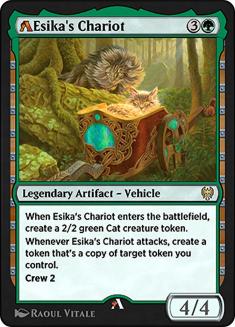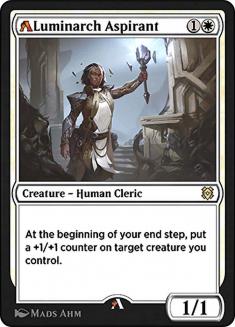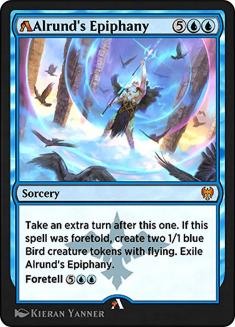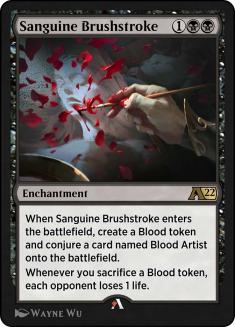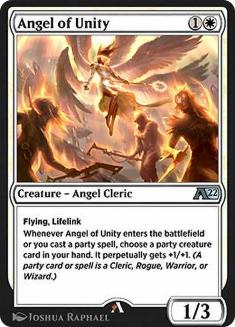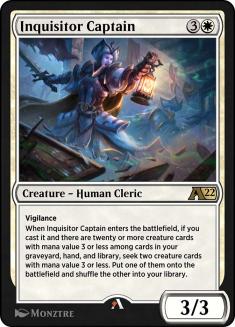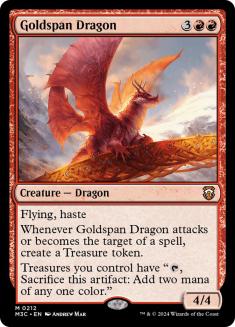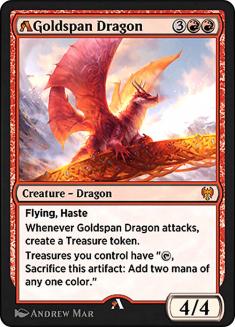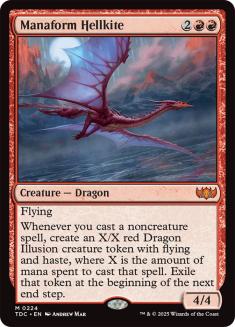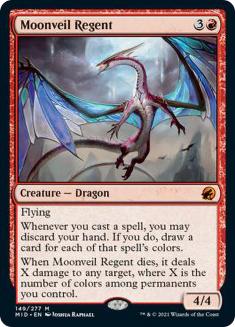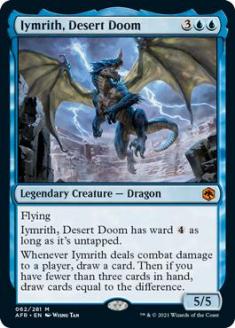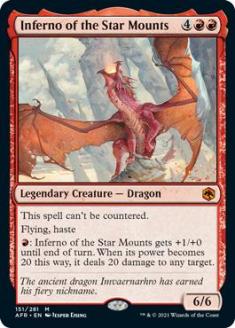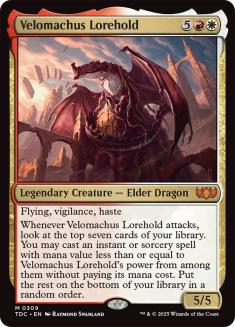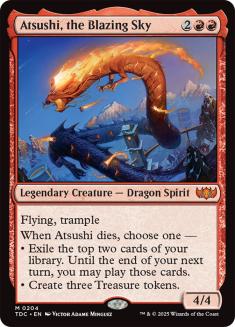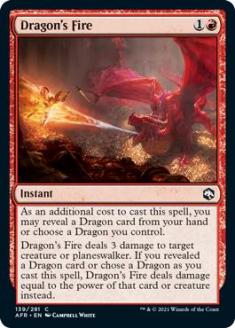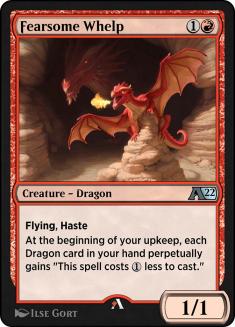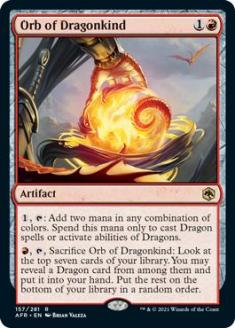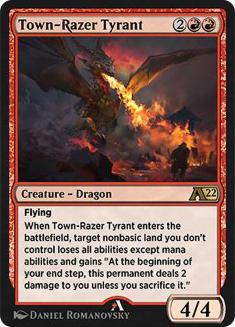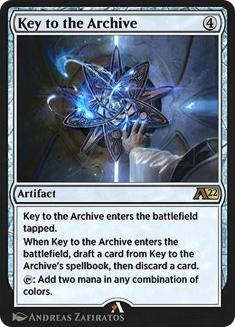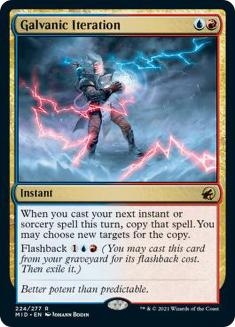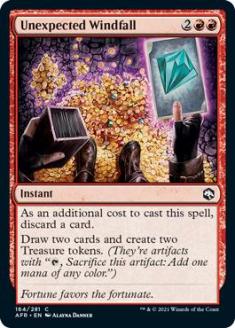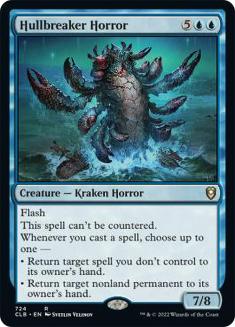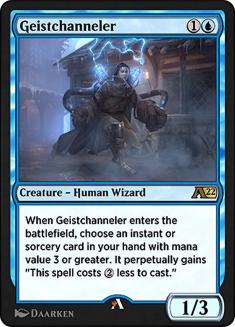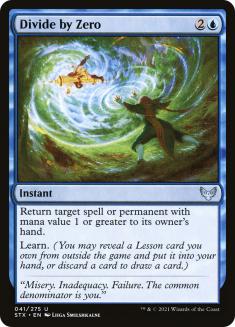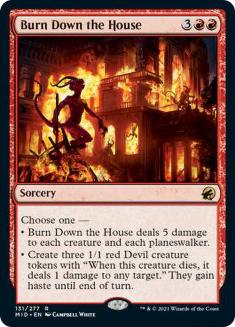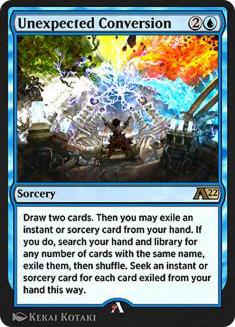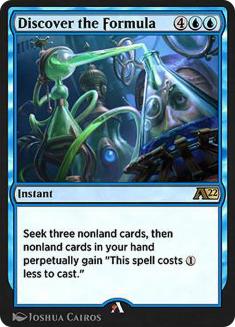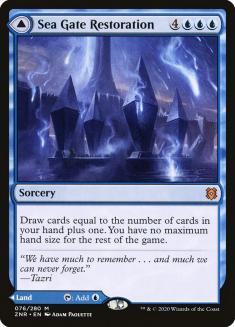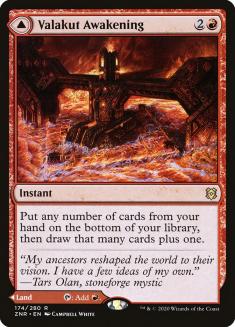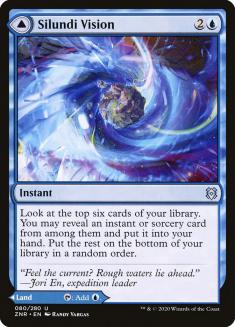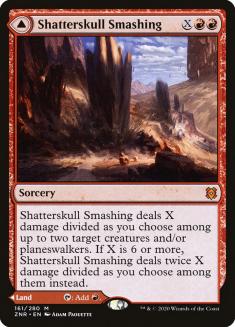The more things change, the more they stay the same. Alchemy essentially forked Standard and started a brand-new direction for digital Magic, potentially rendering Standard obsolete. The Alchemy: Innistrad file is full of strange, groundbreaking cards clearly intended to make this format unique and give it a push to get it moving…
…and yet Izzet is still the best colour pair in Alchemy.
Maybe this was easily predictable, but why has it shaken out this way?
The Alchemy release also changed existing cards as part of a wider rebalancing. All of the main archetypes in Innistrad: Crimson Vow Standard took a hit to one of their central cards and these decks each had to process this loss in their own ways. There are other threats to replace Esika’s Chariot and Luminarch Aspirant at their respective spots on the curve for Mono-Green Aggro and Mono-White Aggro (with the strongest alternatives appearing at the perfect time in this set), but Alrund’s Epiphany is both the namesake of Izzet Epiphany and a thankfully unique effect in Standard. If the new version isn’t good enough, Izzet Epiphany as we know it is off the table.
Alrund’s Epiphany (MTGA) is certainly much worse than its original form but not by enough to invalidate it completely. As Bryan Gottlieb argued in his initial case for banning Alrund’s Epiphany, the rate on an extra-turn effect matters less than the support it has in the format; you’ll gladly pay what seems like a steep price for an effect that breaks the fundamental rules of Magic.
Once competitors at World Championship XXVII and the Innistrad Championship found the formula for enabling Epiphany (notably the Czech team’s focus on Unexpected Windfall), the actual numbers on Epiphany were an afterthought – and the rest of that core survives intact.
This Izzet Epiphany deck, if frozen in time, would find itself in a more hospitable format even though the overall power level is higher and new competitors have arrived on the scene. Mono-Black Sacrifice is a real deck now thanks to Sanguine Brushstroke, preying on the fast aggressive decks like Mono-White Aggro or Mono-Green Aggro (as well as other decks like Gruul Werewolves that get a shot in the arm with Alchemy: Innistrad) but with a clear weakness to anyone taking extra turns – Gerry Thompson noted that he liked his odds against Izzet decks that focused on the new Alchemy additions but groaned whenever the opponent foretold a card on Turn 2.
Meanwhile, Orzhov Clerics rose from the dumping ground of failed tribal decks to become an apex predator in Alchemy. These synergistic creature decks feast on one-dimensional aggro but have trouble applying pressure in the face of interaction – something as simple as Spikefield Hazard on a key Lunarch Veteran can burn down the house of cards.
Inquisitor Captain is the best card in the set and has already spawned a new wave of creature combo decks, using Glasspool Mimic to keep rerolling on the first Captain or just hoping to assemble a large battlefield. Once again, this is a solid recipe against the small creature decks, but a four-drop creature as your first relevant play is a potential disaster against Jwari Disruption and Divide by Zero.
If that were the whole story, Alchemy would look doomed to fail; the same deck that throttled Standard for two sets now is still at it. Luckily, there are enough new tools for Izzet that a wider variety of Izzet decks with different strengths and weaknesses are possible – and it’s even more clear that some form of Izzet is the place to be.
Creatures (8)
Lands (20)
Spells (32)

The name ‘Izzet Dragons’ is open-ended. The deck that made Yuta Takahashi a World Champion has a minor Dragons subtheme in the vein of decks like Esper Dragons from Dragons of Tarkir Standard, with maybe a dozen combined Dragons and cards that care about Dragons. Regular Izzet Epiphany already had some interest in Goldspan Dragon and Smoldering Egg; Yuta just leaned into those harder.
Goldspan Dragon had its wings clipped by Alchemy but is still a strong headliner for that strategy:
Creatures (10)
Lands (22)
Spells (28)

This list gets to double-digit Dragons, but that’s just the start. The Alchemy card pool has more appealing Dragons than you could hope to play even with an exclusive focus on the tribe:
This Dragon spellbook isn’t even exhaustive. Do you remember when Galazeth Prismari was a playable (well, played…) Standard card? Did you remember that Leyline Tyrant existed at all?
We also know there’s a cycle of mythic dragons priced to move in Kamigawa: Neon Dynasty – to say nothing of Alchemy: Kamigawa!
Creatures (19)
- 1 Iymrith, Desert Doom
- 2 Inferno of the Star Mounts
- 4 Moonveil Regent
- 4 Fearsome Whelp
- 4 Town-Razer Tyrant
- 4 Goldspan Dragon (MTGA)
Lands (21)
Spells (20)
- 2 Abrade
- 4 Spikefield Hazard
- 2 Shatterskull Smashing
- 4 Expressive Iteration
- 4 Orb of Dragonkind
- 4 Dragon's Fire
Sideboard

With this many Dragons filling different niches at various mana costs, the old and new incentives for caring about Dragons are easier to embrace. Dragon’s Fire is an appealing removal spell in a format defined by 4/4s (and is useful friendly fire now against all of these Dragons), but it was hard to upgrade in Takahashi’s list; a Smoldering Egg that hadn’t transformed couldn’t help, so it only reached the crucial four toughness breakpoint with Goldspan Dragon. In Alchemy, it’s trivial for a dedicated Dragon deck to make Dragon’s Fire the best removal spell in the format.
A deck with that many Dragons has a top-heavy curve that needs early support. Orb of Dragonkind is a super-charged Mind Stone for this archetype that all but guarantees you access to a specific Dragon later in the game. Fearsome Whelp enables some of the strongest starts in Alchemy, letting you deploy a pair of four-drops on Turn 4 and acting as a lightning rod for removal to clear the way for those heavy-hitters.
However many Dragons you decide to play, Town-razer Tyrant will be one of them. Tyrant is exactly the sort of creature that midrange and control decks want as a sideboard pivot against each other and a Dragon-centric deck gets to start the full set in the maindeck.
This shell is a mostly Mono-Red midrange deck with a light touch of blue – very different from Takahashi’s deck and certainly from any of the other decks here. The basic formula, cheap removal and large threats, fits a description that’s familiar by now, boxing out the aggressive and synergistic creature decks but with a clear weakness to anyone going over the top.
The new way to do that in Alchemy is Key to the Archive:
Key to the Archive is a go-to end-game for decks of all colours and philosophies. Azorius, Dimir, or Esper Control powered by Key are all natural approaches, and it slots seamlessly into Gerry Thompson’s Mono-Black Sacrifice deck. The question isn’t whether it belongs in Izzet. It’s what that Izzet deck looks like.
Key works well with the engine of the old Izzet Epiphany lists while also rendering it less necessary. Key gives you the mana to set up a Galvanic Iteration turn and often a perfect card to copy with it. There’s no other format where you get to double up on Demonic Tutor like this and you can streamline the sequence that made Izzet Epiphany dominate Standard via Time Warp. It competes somewhat directly with Iteration’s former best friend in Unexpected Windfall, giving you a more permanent (if vulnerable and less immediate) mana boost at the same spot on the curve. A deck leaning hard on both Key and Windfall has less room for ways to spend all that mana or the cards that let you survive until that point.
Hullbreaker Horror was briefly poised to supplant Alrund’s Epiphany but retreated back into the ice for the Innistrad Championship. With Epiphany cut down to size and more tools to build a conventional ‘big blue’ deck, Horror is worth another look as a nigh-unbeatable threat against anyone given enough time.
Creatures (5)
Lands (23)
Spells (32)

This list shies away from Expressive Iteration in favour of Behold the Multiverse, which is less powerful on some metrics but excels at setting up Key and plays better with reactive cards like Disdainful Stroke (whose stock has risen substantially now that opponents have real mid-game plans to fight over). Cutting Iteration neuters the main appeal of red and suggests this shell may be more at home philosophically in the Esper colours anyway, but this is useful insofar as the contrasts with classic Izzet Epiphany or this final approach may be illuminating.
Creatures (4)
Lands (20)
Spells (36)

Geistchanneler isn’t an eye-catching card on the surface but has quickly become one of the main reasons to play a spell-heavy Izzet deck. There’s a timely comparison in foretell – Geistchanneler grafts a similar play pattern onto a spell of your choice without leaking any semi-hidden information – but it’s also a kind of weird inversion of Galvanic Iteration. Izzet Epiphany is constructed so that it can build towards a big Iteration + payoff spell turn with the additional mana cost that implies. Geistcatcher erases the Iteration tax so that you can perform that entire sequence ‘on-curve.’
This makes the existing staples of Izzet Epiphany even stronger. Unexpected Windfall is a good bridge from the mid-game to the end-game, but savvy aggro players could stunt your development by casting a threat that demanded an immediate answer on your Windfall turn. With Geistchanneler, you can cast Windfall a turn earlier (with a fine blocker to lessen that pressure) and you are more likely to follow up with another spell on the same turn without having to spend the Treasure tokens. The Galvanic Iteration + Unexpected Windfall lines that gave you a crushing resource advantage in any slower matchup are now available as early as Turn 4! Windfall also mitigates some of the downside of drawing Geistchanneler later when it is less relevant.
Similarly, Divide by Zero is a format-defining interactive card but one that can be somewhat clunky. Divide by Zero as a one-drop lets you tap low for a play you actively want to make without taking the shields down. Mascot Exhibition and other Lessons also welcome Geistchanneler’s cost reduction, and Geistchanneler can even be a useful target for Divide (or Fading Hope) if you want to apply that discount elsewhere.
Other cards get a turn in the spotlight again thanks to Geistchanneler. Burn Down the House went from a focus of early Izzet lists to an afterthought; you needed to interact earlier than that but couldn’t run too much cheap removal alongside Burn Down the House with the mirrors in mind, and it was a weak sweeper against cards like Old-Growth Troll and Faceless Haven. With Geistchanneler, Burn goes from an unreliable card in its intended matchups to a strong card across the board. Burn as a three-mana sweeper stops even the best draws from the creature decks, and a Turn 3 Burn creating Devils is a great way to apply pressure against other slow decks.
Alchemy: Innistrad brings a pair of flashy draw spells that harness the new digital mechanics. Izzet Epiphany is fine with a clean, simple Divination – you want high quantities of both lands and spells and care about your raw resource count – and all the extra words on Unexpected Conversion are worth slogging through. You need some amount of cheap removal that’s poor against other blue decks, but if you compensate for that with maindeck counters like Test of Talents, you risk drawing those at the wrong time too. The expected output of a generic draw spell is much better when you get a mulligan of sorts on these polarized effects.
Six-mana draw spells are a rarity in Constructed Magic (beyond specialized sideboard tools like Commence the Endgame), but Discover the Formula is intriguing. Rather than investing mana now for a discount later, Discover the Formula demands a big deposit upfront but lets you unload your new hand more easily, addressing an inherent downside of these expensive draw spells. Izzet Epiphany is mana-hungry at all phases of the game, but casting Discover implies enough mana that you’d rather guarantee action.
Fathom Trawl couldn’t clear a much lower bar, but Discover the Formula has a good shot. One reason is that this will often be a four-mana draw spell. Geistchanneler into Turn 4 Discover the Formula sets you up perfectly for the rest of what will probably be a rather short game.
Despite that, I think I’m lower on this card than the consensus is. These Izzet shells have never lacked ways to overpower opponents in the end-game and I don’t think this compares well to those other options (even a nerfed Alrund’s Epiphany). The alternatives can all flip games by themselves or bail you out from behind. Discover only does that if you can afford to take a turn off drawing cards and then is contingent on those cards mattering.
Izzet has more playable modal DFCs than any other colour pair and the Geistchanneler discount brings more of them into range. Sea Gate Restoration is hard to cast and even harder to copy with Galvanic Iteration, but both of those are much easier now and the ceiling there is high. Valakut Awakening has always been somewhat underappreciated and a one-mana version along with Iteration lets you tear through your deck in search of specific cards (like the Alrund’s Epiphany to copy with a flashbacked Iteration).
The modal DFCs create odd incentives with these seek effects. The cheap DFCs like Spikefield Hazard and Jwari Disruption rapidly become little more than lands that enter the battlefield tapped, diluting the pool of relevant instants or sorceries when you are digging for action. Then again, Izzet Epiphany usually has good uses for extra mana and absolutely needs a certain baseline amount of mana to function. For a land-light draw that casts Unexpected Conversion and misses, a DFC is the card you most want to seek. On the other end, by the time you cast Discover the Formula, you’d almost always prefer a ‘real’ spell at a good rate.
It’s tough to make any definitive statements about Alchemy when there has been exactly one tournament with the format and no high-stakes competition of any kind, but if you have to place a bet somewhere, you can safely assume Stormcarved Coast isn’t going anywhere.


